Explore Muscat - Oman Travel, Asia
Muscat, the capital city of Oman, offers travelers a perfect blend of history, culture, and natural beauty. Nestled between the rugged Hajar Mountains and the sparkling Arabian Sea, this picturesque city captivates visitors with its pristine beaches, historic forts, and modern architecture. From wandering through vibrant souks filled with handcrafted goods to exploring ancient landmarks steeped in history, Muscat invites you to immerse yourself in the heart of Omani culture. Whether you’re an adventurer, a history enthusiast, or a foodie, Muscat has something special for every traveler.
Population: Approximately 1.7 million in 2024.
Economy: Muscat's economy thrives on oil and gas exports, tourism, and trade. As Oman's capital, it plays a key role in the nation’s financial sector, with growing investments in infrastructure and logistics.
Landmarks: Famous for the Sultan Qaboos Grand Mosque, Royal Opera House Muscat, and the Al Jalali and Al Mirani Forts.
Oman
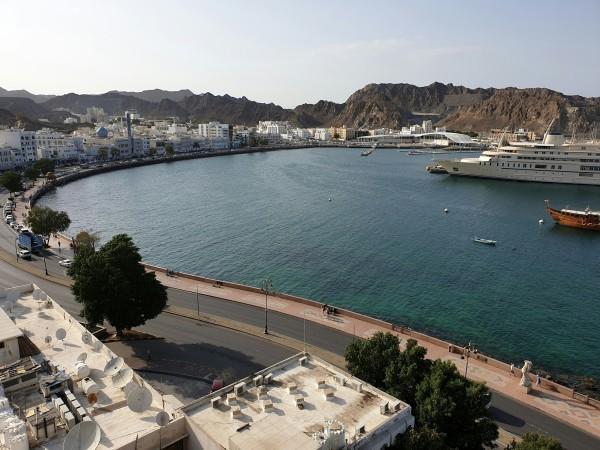
Overview of Muscat
History & Cultural Influence
For centuries, Muscat has been a vital trading hub, linking the East and West with its bustling ports. Evidence of Muscat’s significance can be found in its architecture, traditions, and landmarks. As you stroll through the city, you’ll notice the influence of various civilizations, including the Portuguese, Persians, and Ottomans, each leaving their mark on the city’s heritage. In terms of culture, Muscat remains rooted in Islamic traditions, yet it embraces modernity with open arms. It’s a city where the past seamlessly meets the present, and where every corner tells a story of resilience and progress.
Interaction with The Locals
Muscat, the capital of Oman, has a population of Omani citizens and expatriates, with Omanis making up the majority. The local population is known for their warm hospitality and deep respect for tradition, while the expat community brings a diverse range of cultures to the city. Omanis are proud of their heritage, with Islam playing a central role in daily life, yet they are welcoming to visitors and open to sharing their culture.
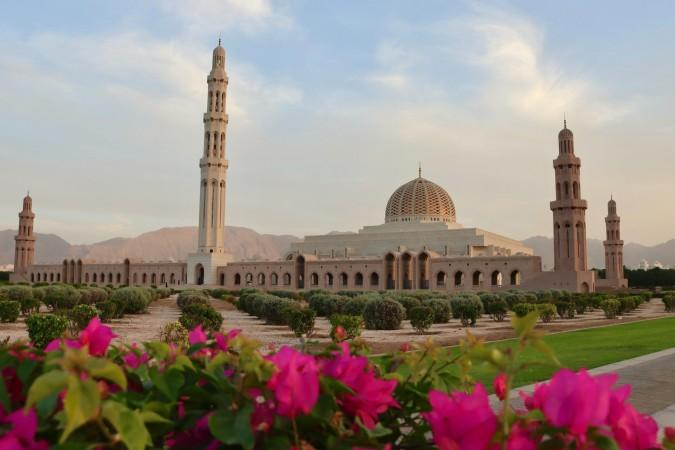
Sultan Qaboos Grand Mosque - © Hongbin
Top Attractions in Muscat
Sultan Qaboos Grand Mosque
The Sultan Qaboos Grand Mosque is one of the most iconic landmarks in Muscat and a masterpiece of Islamic architecture. With its magnificent marble walls, intricate mosaics, and the world’s second-largest chandelier, this mosque is a stunning sight to behold. Visitors can go around the mosque's calm prayer halls and view the world's second-largest Persian carpet. It’s open to non-Muslim visitors in the mornings, offering a peaceful atmosphere to appreciate Islamic art and culture.
Royal Opera House Muscat
The Royal Opera House Muscat is a cultural gem that hosts world-class performances, including opera, ballet, and traditional Omani music. This architectural marvel blends modern and traditional Omani styles, with its grand halls and intricate designs. Even if you're not attending a performance, the opera house is worth a visit for its beauty and the cultural significance it holds in the region.
Al Jalali and Al Mirani Forts
The Al Jalali and Al Mirani Forts are historic structures dating back to the sixteenth century that were built by the Portuguese. These forts originally played an important role in defending the city from invaders. Today, they provide spectacular panoramic views of Muscat and its shoreline. Exploring the forts allows visitors to step back in time and experience Oman’s military history firsthand.
Mutrah Souq
For a taste of traditional Omani life, head to Mutrah Souq, one of the oldest and most vibrant markets in the Arabian Peninsula. Here, you’ll find a treasure trove of goods, from fragrant spices and perfumes to intricate silver jewelry and handmade textiles. This bustling marketplace is an ideal spot for picking up souvenirs, while its lively energy and rich scents transport you to another era.
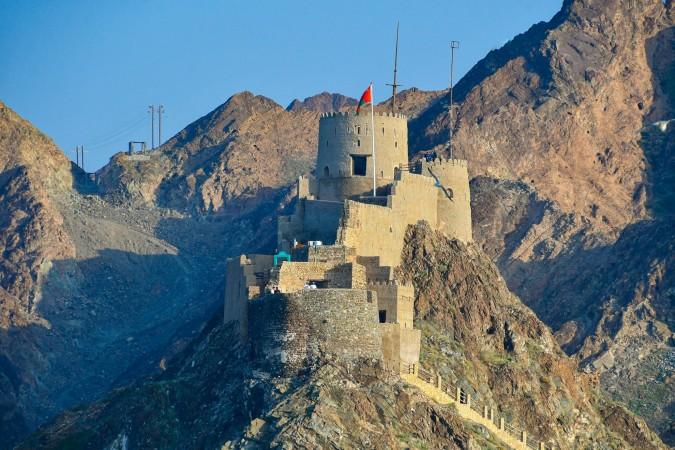
Mutrah Souq - © SnapSaga
Must-Try Dishes in Muscat
Muscat’s local cuisine is a reflection of Oman’s rich cultural heritage, offering a variety of traditional dishes that highlight the country's unique flavors. In addition to the iconic local dishes, there are several other specialties that visitors should try to fully appreciate Omani cuisine.
- Shuwa: A highlight of Omani cuisine, Shuwa is slow-cooked lamb that’s marinated in spices and wrapped in banana leaves before being cooked underground for up to 48 hours. The result is incredibly tender and flavorful meat, often served during special occasions like Eid.
- Majboos: Also known as Kabsa, Majboos is a fragrant rice dish cooked with a variety of spices such as saffron, cinnamon, and cardamom, typically accompanied by chicken, lamb, or fish. It’s a flavorful, filling meal and a staple in many Omani households.
- Mashuai: Mashuai is a traditional dish made of roasted kingfish served with rice and a tangy lemon sauce. This coastal favorite is known for its fresh, delicate flavors and is popular throughout Muscat’s seaside restaurants.
- Omani Halwa: A popular sweet treat, Omani Halwa is made from sugar, rosewater, ghee, and a blend of spices like saffron and cardamom. It has a sticky, jelly-like consistency and is often served with dates and coffee during social gatherings.
- Harees: Harees is a comforting dish made of wheat and meat, slow-cooked until it reaches a porridge-like consistency. It’s especially popular during Ramadan and other religious festivals, offering a warm and hearty meal that reflects the simplicity of traditional Omani cooking.
- Mishkak: A popular street food in Oman, Mishkak consists of skewers of marinated meat (typically beef, chicken, or lamb) grilled over hot coals. The marinade, made with spices, garlic, and vinegar, gives the meat a smoky, tangy flavor. It’s often served with flatbread and is a common sight at roadside stalls and local festivals.
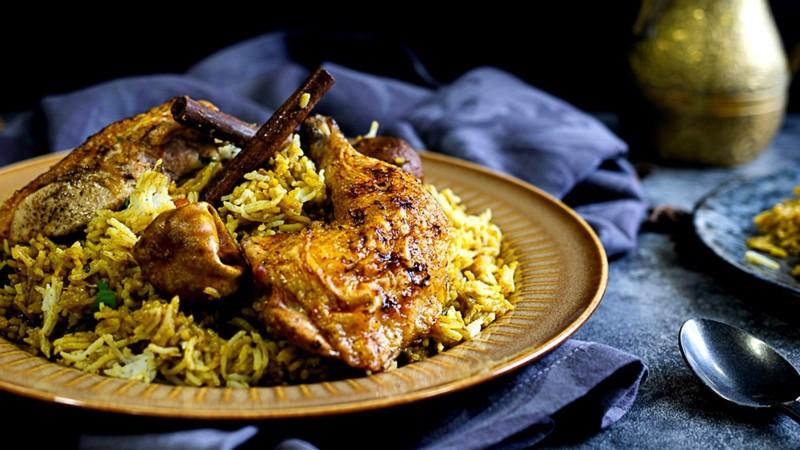
Majboos - © Chef Middle East At Home
Festivals & Local Celebrations
Muscat is home to several festivals and celebrations that showcase the country’s vibrant culture and traditions. These events are a great way to experience the local way of life and witness the sense of community that defines Oman.
Muscat Festival
Held annually in January and February, the Muscat Festival is a month-long celebration of Omani culture, arts, and traditions. It features cultural performances, traditional crafts, and local food stalls. Visitors can experience everything from folk dances to camel races and art exhibits, making it a must-attend event for those interested in Oman’s heritage.
Eid al-Fitr & Eid al-Adha
As a predominantly Muslim country, Oman celebrates both Eid al-Fitr and Eid al-Adha with great enthusiasm. These Islamic festivals are marked by prayer, feasts, and social gatherings. During these times, families come together to share meals, and visitors can witness the strong sense of community and generosity that permeates Omani culture.
Oman’s National Day
Celebrated on November 18th, Oman’s National Day commemorates the country’s independence and the reign of Sultan Qaboos bin Said. Parades, fireworks, and traditional performances take place throughout Muscat, creating a lively and patriotic atmosphere. It’s a great time to be in the city and experience the national pride that runs deep in Omani society.

Oman’s National Day celebrations - © Edarabia
What to Do in Muscat
- Dolphin Watching in Muscat: Muscat’s coastline is home to some of the best snorkeling spots in the region. Places like Bandar Al Khayran and Daymaniyat Islands offer crystal-clear waters teeming with marine life. For those seeking adventure, dolphin-watching tours are popular in Muscat, where you can observe pods of dolphins swimming through the azure waters of the Arabian Sea.
- Desert Safari: For a taste of the Omani desert, head out on a desert safari where you’ll experience dune bashing, camel riding, and the serene beauty of the vast Omani desert. The nearby Wahiba Sands offers an unforgettable landscape with towering dunes and the chance to spend a night under the stars in a traditional Bedouin camp.
- Historical & Cultural Tours: History lovers can enjoy guided tours of Muscat’s ancient landmarks, including Bait Al Zubair Museum and Al Alam Palace. These tours offer in-depth insights into Omani heritage and the city’s pivotal role in regional history. Visiting local mosques and souqs allows you to experience Omani culture up close.
Shopping in Muscat
- Mutrah Souq: The Mutrah Souq is one of Muscat’s most famous traditional markets and a must-visit for anyone interested in buying authentic Omani goods. Here, you’ll find a vibrant collection of items such as spices, perfumes, silverware, textiles, and handcrafted jewelry.
- Muscat Grand Mall: For a more modern shopping experience, head to the Muscat Grand Mall, one of the city’s largest and most popular malls. It houses a mix of international brands, local boutiques, and a variety of dining options.
- Oman Avenues Mall: Another modern shopping destination, Oman Avenues Mall, offers an array of luxury and lifestyle stores, from fashion to electronics. It’s an excellent spot for high-end shopping with family-friendly amenities, including restaurants, a cinema, and entertainment options for kids.
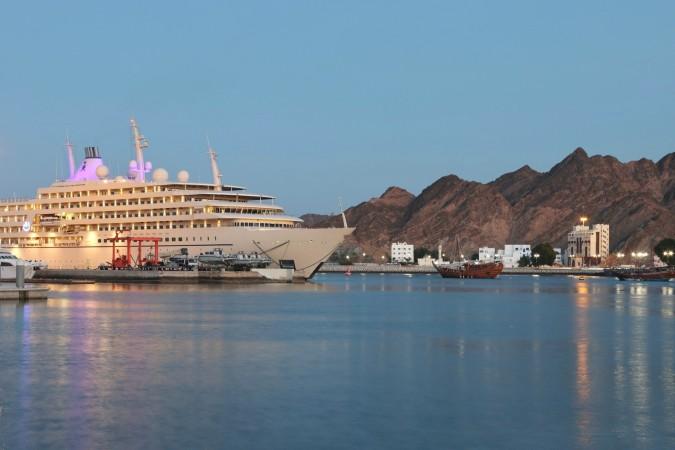
Experience Muscat Bay boat tours - © Hongbin
Weather in Muscat: Best Time to Visit
Muscat experiences a hot desert climate typical of the Arabian Peninsula, with long, scorching summers and mild winters. Understanding Muscat’s weather can help you plan the best time to visit the city, depending on your preferences for temperature and activities.
Summer in Muscat
Summers in Muscat are extremely hot, with temperatures often exceeding 40°C (104°F). The humidity, especially along the coast, can make it feel even hotter. Outdoor activities can be challenging during these months, so if you visit during this period, it’s best to stick to indoor attractions, such as museums and shopping malls, or spend time at luxury resorts where air conditioning is readily available.
Winter in Muscat
The winter months offer a much more pleasant climate, with temperatures ranging between 18°C and 30°C (64°F to 86°F). This is considered the best time to visit Muscat, as the cooler weather is ideal for outdoor activities like exploring historical sites, beach trips, and desert safaris. Rainfall is rare but can occur between December and March.
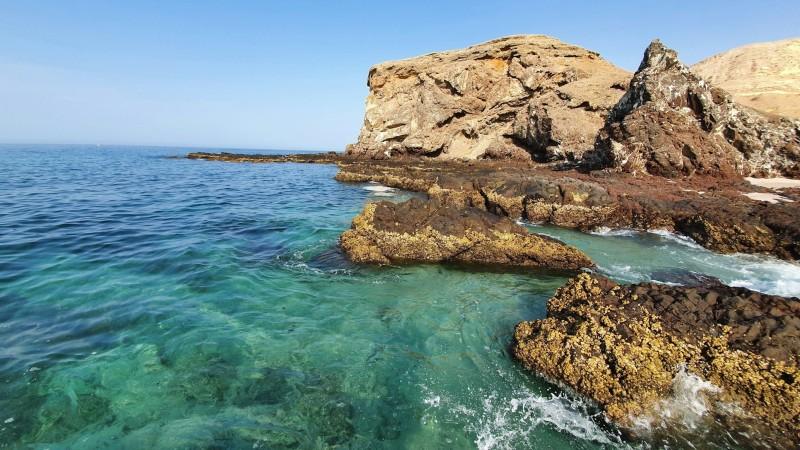
A clear day to explore Daymaniyat Islands - © Ghulam Mustafa
Essential Travel Information
Getting Around Muscat
- Public Transportation: Muscat’s public transport system is well-developed, with Mwasalat buses covering most of the city and surrounding areas. These buses are affordable, air-conditioned, and provide a convenient way to travel between major landmarks, malls, and residential areas. Tickets can be purchased from drivers or bus stations.
- Taxis: Taxis are a popular mode of transportation in Muscat, and they can be easily found at airports, hotels, and major tourist spots. Orange and white-colored taxis are traditional, and it’s important to negotiate the fare before starting your journey, as most taxis do not use meters.
- Car Rentals: Renting a car is a great way to explore Muscat and the surrounding areas at your own pace. Driving in Muscat is generally straightforward, with well-maintained roads and clear signage. However, be prepared for some traffic in busy areas during peak times.
ATM & Banking Services
Muscat offers a modern banking system with easy access to ATMs and currency exchange services throughout the city. ATMs can be found in key locations such as shopping malls, tourist spots, and the airport, and they typically accept international debit and credit cards. Currency exchange services are available at various locations, including exchange offices and hotels, though exchange rates may vary. Credit and debit cards are widely accepted at hotels, restaurants, and large stores, but it's advisable to carry some cash, especially when visiting local markets or smaller establishments.
Where to Stay in Muscat
- Luxury Hotels & Resorts: For travelers seeking an indulgent experience, Muscat is home to several luxury hotels and beachfront resorts. These properties offer stunning views, premium services, and exclusive amenities such as private beaches, world-class dining, and luxurious spas.
- Mid-Range Hotels: These hotels typically offer modern amenities, such as rooftop pools, fitness centers, and dining options, while being conveniently located near major attractions and city centers. Ideal for families or business travelers, these options provide a comfortable and affordable stay.
- Desert Camps: For those seeking a more authentic or adventurous experience, there are opportunities to stay in traditional desert camps. These unique accommodations allow travelers to experience Omani hospitality and culture up close, whether in a cozy, traditional setting or under the stars in a desert environment.
Articles for you

Explore Yala National Park - Sri Lanka Travel, Asia
Tucked away in Sri Lanka’s southeastern corner, Yala National Park is where wild nature meets deep tradition. Known worldwide for its leopard population, the park is also home to elephants, sloth bears, crocodiles, and hundreds of bird species. Beyond wildlife, Yala opens doors to a cultural landscape dotted with ancient temples, Buddhist ruins, and coastal villages. For travelers seeking more than just a safari, Yala offers a chance to explore eco-tourism, local communities, and sacred heritage sites.
Population: The Yala National Park area doesn’t have a human population.
Economy: The economy around Yala National Park thrives on a blend of eco-tourism, agriculture, and local services. Safari tours, eco-lodges, and cultural experiences drive steady income for nearby towns like Tissamaharama and Kataragama, supporting thousands of families.
Landmarks: Famous for Block I of Yala and wildlife encounters, including elephants, sloth bears, crocodiles, and exotic bird species.

Explore Galle - Sri Lanka Travel, Asia
Nestled on Sri Lanka’s southern coastline, Galle is a vibrant city where history meets the sea. Its cobbled streets, colonial architecture, and serene beaches make it a must-visit destination for travelers seeking a blend of culture, adventure, and relaxation. A UNESCO World Heritage site, Galle captivates visitors with its Dutch Fort, bustling markets, and friendly locals. Whether you’re exploring the ramparts at sunset or savoring fresh seafood by the shore, Galle promises an unforgettable journey into Sri Lanka’s heritage.
Population: Approximately 113,000 in 2023.
Economy: Galle’s economy thrives on tourism, trade, and fisheries. The city’s historic fort, colonial architecture, and coastal charm draw thousands of international visitors each year, making tourism its main economic driver. Fishing remains vital for local livelihoods, supplying fresh seafood across the region.
Landmarks: Famous for the Galle Fort, Dutch Reformed Church & Maritime Museum, and Unawatuna Beach.

Explore Bentota - Sri Lanka Travel, Asia
Nestled along Sri Lanka’s southwestern coast, Bentota is a tropical paradise that blends golden beaches, vibrant culture, and thrilling adventures. Famous for its calm waters, luxury resorts, and scenic river estuary, Bentota has become a top destination for travelers seeking both relaxation and authentic experiences. From serene beach walks at sunrise to adrenaline-pumping water sports, this coastal town offers a perfect balance of leisure and exploration. With its proximity to Colombo and Galle, Bentota is easy to reach, making it an ideal stop for both short escapes and extended holidays.
Population: Approximately 37,000 in 2023.
Economy: Bentota’s economy thrives mainly on tourism, which drives local businesses such as hotels, restaurants, and wellness retreats. The town also benefits from fishing, coconut cultivation, and handicrafts like wood carving and batik textiles. Many residents rely on the growing demand for water sports and Ayurvedic treatments, making tourism the backbone of both income and employment in the area.
Landmarks: Famous for Bentota Beach, Bentota River Safari, and Kande Vihara Temple.

Explore Mirissa - Sri Lanka Travel, Asia
Mirissa is a charming coastal town on Sri Lanka’s southern shoreline. Known for its golden beaches, turquoise waters, and vibrant marine life, it has become a must-visit stop for travelers exploring the island. Many come for whale watching, surfing, and sunset views at Coconut Tree Hill, but Mirissa offers much more than postcard beauty. The fishing boats you see anchored by the bay carry generations of stories. Local traditions, delicious cuisine, and a laid-back rhythm of life shape every visitor’s experience.
Population: Approximately 4,700 in 2023.
Economy: Mirissa’s economy is largely shaped by its coastal location. Fishing has long been the backbone of local livelihoods, with generations relying on the Indian Ocean for income. In recent decades, tourism has become the main driver of growth, thanks to whale watching, surfing, and beachside hospitality.
Landmarks: Famous for Mirissa Beach, Coconut Tree Hill, and Parrot Rock Bridge.

Explore Nuwara Eliya - Sri Lanka Travel, Asia
Tucked away in the Central Highlands of Sri Lanka, Nuwara Eliya is often called “Little England”. With its rolling tea plantations, cool misty mornings, and colonial charm, this mountain town feels like a step into another world. Travelers come here to breathe fresh air, walk through flower gardens, sip the finest Ceylon Tea, and enjoy a pace of life far from the island’s busy cities. Whether you’re drawn by scenic landscapes, heritage architecture, or the warmth of its people, Nuwara Eliya is a destination that blends nature, culture, and history in perfect harmony.
Population: Approximately 781,000 in 2023.
Economy: Nuwara Eliya’s economy thrives mainly on tea production, as it sits in the heart of Sri Lanka’s central highlands, famous worldwide for Ceylon Tea. The city also benefits from a growing tourism industry, attracting visitors with its colonial charm, cool climate, and scenic landscapes.
Landmarks: Famous for Gregory Lake, Hakgala Botanical Garden, and Victoria Park.

Explore Sukau - Malaysia Travel, Asia
Nestled on the banks of the Kinabatangan River in Sabah, Malaysian Borneo, Sukau is a destination where wildlife, culture, and conservation come together. Known as one of Asia’s top spots for river safaris and eco-tourism, this quiet village offers a front-row seat to encounters with Bornean orangutans, pygmy elephants, proboscis monkeys, and exotic birdlife.
Population: Approximately 1,400 in 2019.
Economy: Sukau’s economy is shaped by its riverine location and natural resources. Traditionally, the Orang Sungai community relied on fishing, small-scale farming, and forest gathering for their livelihood. Today, the village has shifted toward eco-tourism, with river cruises, jungle trekking, and homestays providing income.
Landmarks: Famous for the Kinabatangan River cruises, Gomantong Caves, and Ox-bow lakes and wetlands.
